Medieval History
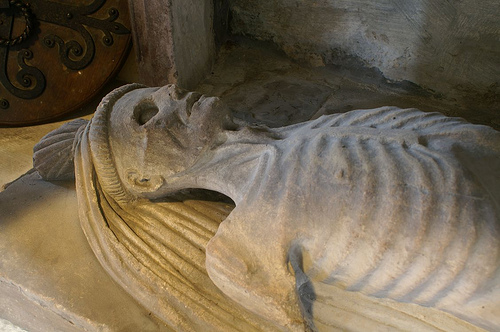
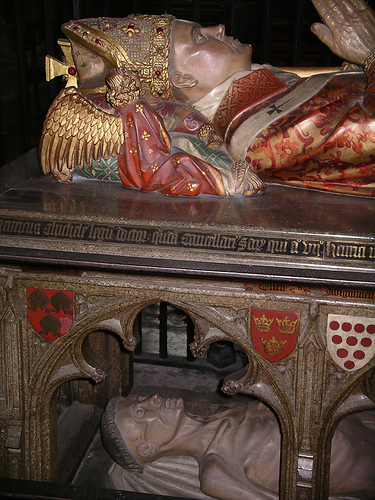
Chichele monument in Canterbury Cathedral, photo by Flambard
Around the same time as the Golafre monument is the tomb of Archbishop Henry Chichele (died 1443) in Canterbury Cathedral. On the upper level Chichele is portrayed in full pontificals, while below in the openwork tomb chest he is portrayed in the grips of rigor-mortis. On the monument is the inscription: 'I was a pauper born, then to primate here raised, now I am cut down and served up for worms ... Whoever who may be who will pass by, I ask for your remembrance.'
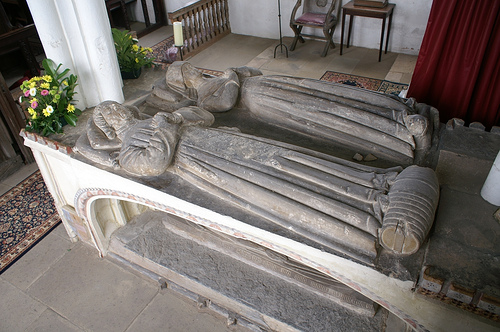
Barton monument at Holme-by-Newark in Nottinghamshire
A lot later is the similar monument to John Barton a wealthy wool merchant and self-made man, who died in 1491. He erected the monument during his lifetime, positioning it between the high altar and Lady altar of Holme-by-Newark church in Nottinghamshire, smack in front of where he sat to hear mass. In his will he asked to be buried in the novo monumento he had erected. On the top he is portrayed as a successful and pious businessman of advanced years, lying with his large purse and rosary beads beside the figure of his wife. Below is a wonderful 'screaming' corpse. On the side of the slab that supports the corpse a quote from Job 19 is carved: 'have pity on me, you my friends, for the hand of the lord has touched me' - The monument was obviously intended to be a momento mori for his friends and family.
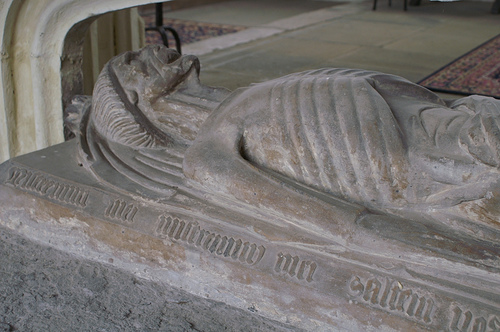
A detail of the Barton monument.
For those with less disposable income cheaper versions of the transi tomb were available. In the late fifteenth and early sixteenth century shroud brasses proliferated, these portrayed the deceased in the attitude of prayer wrapped in their winding sheet. The brass of William Lenthall (died 1497) at Great Haseley, Oxfordshire is a fairly typical example.
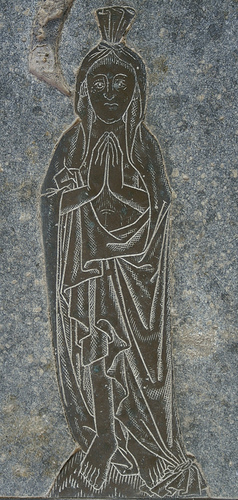
Lenthall brass at Great Haseley in Oxfordshire
The most extreme development of this sort of image is perhaps the monumental brass commemorating the priest Ralph Hamsterley who died in 1518. He is portrayed as a skeletal figure wrapped in a shroud, being merrily munched by worms. Even his eyes are being devoured and they have got in between his ribs. Ralph was warden of Merton College Oxford and a pluralist. He had four of these brasses erected one over his grave in Merton and one in each of his livings, the one he erected in Oddington in Oxfordshire remains.
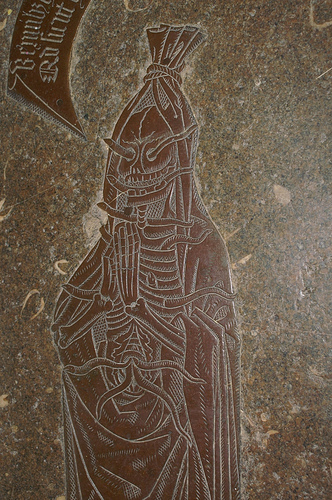
Hamsterley brass at Oddington in Oxfordshire
Lastly and equally grisly are the shrouded alabaster figures commemorating Thomas Beresford (died 1473) and his wife at Fenny Bentley in Derbyshire. Wrapped up with ties round their legs like overgrown chrysalises.
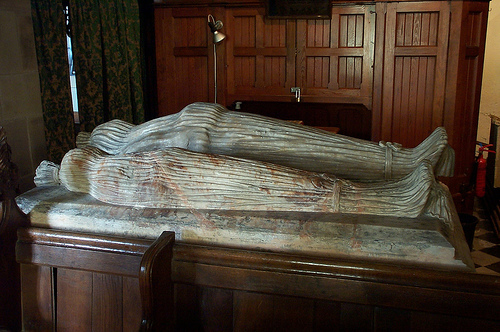
Beresford monument at Fenny Bentley in Derbyshire
- This Is 15th Century English, But What Does It Say?
Salisbury Cathedral is asking medievalists for help in deciphering a mysterious inscription hidden behind a monument for hundreds of years. The inscription, painted in black gothic letters, is thought to be one of the earliest written in English in any...
- Ejected!
Not at all medieval, but on the wall of the chancel at Molland is this fabulous baroque monument commemorating an interesting man. It commemorates Daniel Berry one time vicar of Molland. I will let the inscription tell his story: 'Under...
- A Wooden Effigy
This is the first of three or four articles on one church building, the church is St Michael's Laxton, in Nottinghamshire - a building of considerable interest. On the north side of the chancel is this curious tomb, commemorating...
- Wool Merchants
I had a quick trip on Saturday to the church of St Cornelius at Linwood, near Market Rasen in Lincolnshire. The church contains two of the finest early fifteenth century monumental brasses in the county. Sadly they are little neglected and covered in...
- An Effigy In Dorchester Abbey, Oxfordshire
In the south chancel chapel in the former Augustinian abbey at Dorchester-on-Thames in Oxfordshire is a plain tomb chest, which supports one of the finest medieval miltary effigies in England. The effigy shows a recumbent man dressed in top to two in...
Medieval History
A taste for the macabre - late medieval cadaver tombs

Golafre monument at Fyfield in Berkshire
In the fifteenth and early sixteenth century people had rather a taste for the macabre when it came to funeral monuments. From the 1440s onwards it was common for the higher clergy, gentry and merchants to erect transi tombs - double level tombs in which they were portrayed in all their earthly finery above and with image of their decomposing corpse in the openwork tomb chest below. Many of these monuments were erected during the lifetime of the individual to serve as a memento mori for them during their remaining years and for those who saw it in the years after. One of the earliest monuments of this sort is that of Sir John Golafre who died in 1442 and is buried at Fyfield in Berkshire. He was portrayed in a rather advanced state of decay, with sunken eyes, taut neck and exposed ribs. The top of the monument is surmounted with an effigy of Golafre in full plate armour.

Chichele monument in Canterbury Cathedral, photo by Flambard
Around the same time as the Golafre monument is the tomb of Archbishop Henry Chichele (died 1443) in Canterbury Cathedral. On the upper level Chichele is portrayed in full pontificals, while below in the openwork tomb chest he is portrayed in the grips of rigor-mortis. On the monument is the inscription: 'I was a pauper born, then to primate here raised, now I am cut down and served up for worms ... Whoever who may be who will pass by, I ask for your remembrance.'

Barton monument at Holme-by-Newark in Nottinghamshire
A lot later is the similar monument to John Barton a wealthy wool merchant and self-made man, who died in 1491. He erected the monument during his lifetime, positioning it between the high altar and Lady altar of Holme-by-Newark church in Nottinghamshire, smack in front of where he sat to hear mass. In his will he asked to be buried in the novo monumento he had erected. On the top he is portrayed as a successful and pious businessman of advanced years, lying with his large purse and rosary beads beside the figure of his wife. Below is a wonderful 'screaming' corpse. On the side of the slab that supports the corpse a quote from Job 19 is carved: 'have pity on me, you my friends, for the hand of the lord has touched me' - The monument was obviously intended to be a momento mori for his friends and family.

A detail of the Barton monument.
For those with less disposable income cheaper versions of the transi tomb were available. In the late fifteenth and early sixteenth century shroud brasses proliferated, these portrayed the deceased in the attitude of prayer wrapped in their winding sheet. The brass of William Lenthall (died 1497) at Great Haseley, Oxfordshire is a fairly typical example.

Lenthall brass at Great Haseley in Oxfordshire
The most extreme development of this sort of image is perhaps the monumental brass commemorating the priest Ralph Hamsterley who died in 1518. He is portrayed as a skeletal figure wrapped in a shroud, being merrily munched by worms. Even his eyes are being devoured and they have got in between his ribs. Ralph was warden of Merton College Oxford and a pluralist. He had four of these brasses erected one over his grave in Merton and one in each of his livings, the one he erected in Oddington in Oxfordshire remains.

Hamsterley brass at Oddington in Oxfordshire
Lastly and equally grisly are the shrouded alabaster figures commemorating Thomas Beresford (died 1473) and his wife at Fenny Bentley in Derbyshire. Wrapped up with ties round their legs like overgrown chrysalises.

Beresford monument at Fenny Bentley in Derbyshire
- This Is 15th Century English, But What Does It Say?
Salisbury Cathedral is asking medievalists for help in deciphering a mysterious inscription hidden behind a monument for hundreds of years. The inscription, painted in black gothic letters, is thought to be one of the earliest written in English in any...
- Ejected!
Not at all medieval, but on the wall of the chancel at Molland is this fabulous baroque monument commemorating an interesting man. It commemorates Daniel Berry one time vicar of Molland. I will let the inscription tell his story: 'Under...
- A Wooden Effigy
This is the first of three or four articles on one church building, the church is St Michael's Laxton, in Nottinghamshire - a building of considerable interest. On the north side of the chancel is this curious tomb, commemorating...
- Wool Merchants
I had a quick trip on Saturday to the church of St Cornelius at Linwood, near Market Rasen in Lincolnshire. The church contains two of the finest early fifteenth century monumental brasses in the county. Sadly they are little neglected and covered in...
- An Effigy In Dorchester Abbey, Oxfordshire
In the south chancel chapel in the former Augustinian abbey at Dorchester-on-Thames in Oxfordshire is a plain tomb chest, which supports one of the finest medieval miltary effigies in England. The effigy shows a recumbent man dressed in top to two in...
